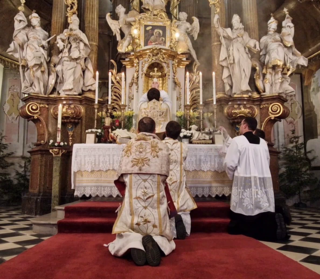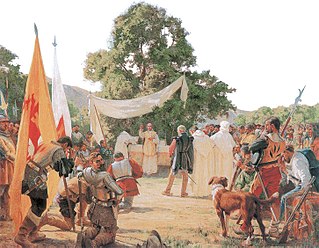
The Roman Missal is the title of several missals used in the celebration of the Roman Rite. Along with other liturgical books of the Roman Rite, the Roman Missal contains the texts and rubrics for the celebration of the most common liturgy and Mass of the Catholic Church.

Mass is the main Eucharistic liturgical service in many forms of Western Christianity. The term Mass is commonly used in the Catholic Church, Western Rite Orthodoxy, Old Catholicism, and Independent Catholicism. The term is also used in some Lutheran churches, as well as in some Anglican churches, and on rare occasion by other Protestant churches.

The Mass of Paul VI, also known as the Ordinary Form or Novus Ordo, is the most commonly used liturgy in the Catholic Church. It was promulgated by Pope Paul VI in 1969 and its liturgical books were published in 1970; those books were then revised in 1975, they were revised again by Pope John Paul II in 2000, and a third revision was published in 2002.

The Tridentine Mass, also known as the Traditional Latin Mass, the Traditional Rite, or the Extraordinary Form, is the liturgy in the Roman Missal of the Catholic Church codified in 1570 and published thereafter with amendments up to 1962. Celebrated almost exclusively in Ecclesiastical Latin, it was the most widely used Eucharistic liturgy in the world from its issuance in 1570 until the introduction of the Mass of Paul VI.

A Requiem or Requiem Mass, also known as Mass for the dead or Mass of the dead, is a Mass of the Catholic Church offered for the repose of the soul or souls of one or more deceased persons, using a particular form of the Roman Missal. It is usually celebrated in the context of a funeral.

A Pontifical High Mass, also called Solemn Pontifical Mass, is a Solemn or High Mass celebrated by a bishop using certain prescribed ceremonies. Although in modern English the word "pontifical" is almost exclusively associated with the pope, any bishop may be properly called a pontiff. Thus, the celebrant of a Pontifical High Mass may be the pope, any bishop or any other prelate who is allowed to wear pontificals.

In Christian liturgy, "the Pax" is an abbreviation of the Latin salutations "pax vobis" or "pax vobiscum", which are used in the Catholic Mass, the Lutheran Divine Service, and the Western Orthodox Mass.
The ordinary, in Catholic liturgies, refers to the part of the Mass or of the canonical hours that is reasonably constant without regard to the date on which the service is performed. It is contrasted to the proper, which is that part of these liturgies that varies according to the date, either representing an observance within the liturgical year, or of a particular saint or significant event, or to the common which contains those parts that are common to an entire category of saints such as apostles or martyrs.

The Roman Rite is the most common ritual family for performing the ecclesiastical services of the Latin Church, the largest of the sui iuris particular churches that comprise the Catholic Church. The Roman Rite governs rites such as the Roman Mass and the Liturgy of the Hours as well as the manner in which sacraments and blessings are performed.

Missa cantata is a form of Tridentine Mass defined officially in 1960 as a sung Mass celebrated without sacred ministers, i.e., deacon and subdeacon.

Solemn Mass is the full ceremonial form of a Mass, predominantly associated with the Tridentine Mass where it is celebrated by a priest with a deacon and a subdeacon, requiring most of the parts of the Mass to be sung, and the use of incense. It is also called High Mass or Solemn High Mass.
Missale Romanum is the incipit of an apostolic constitution issued by Pope Paul VI on 3 April 1969. It promulgated the new revised version of the Roman Missal.

The Canon of the Mass, also known as the Canon of the Roman Mass and in the Mass of Paul VI as the Roman Canon or Eucharistic Prayer I, is the oldest anaphora used in the Roman Rite of Mass. The name Canon Missæ was used in the Tridentine Missal from the first typical edition of Pope Pius V in 1570 to that of Pope John XXIII in 1962 to describe the part of the Mass of the Roman Rite that began after the Sanctus with the words Te igitur. All editions preceding that of 1962 place the indication "Canon Missae" at the head of each page from that point until the end of the Mass; that of 1962 does so only until the page preceding the Pater Noster and places the heading "Ordo Missae" on the following pages.

The Premonstratensian Rite or Norbertine Rite is the liturgical rite, distinct from the Roman Rite, specific to the Premonstratensian Order of the Roman Catholic Church
Benedicamus Domino is a closing salutation that was formerly used in the Latin Mass instead of the Ite, missa est in Masses which lack the Gloria. The response, said afterwards, is Deo gratias. It is also sung as a versicle at the end of all Offices.

The Mass is the central liturgical service of the Eucharist in the Catholic Church, in which bread and wine are consecrated and become the body and blood of Christ. As defined by the Church at the Council of Trent, in the Mass "the same Christ who offered himself once in a bloody manner on the altar of the cross, is present and offered in an unbloody manner". The Church describes the Mass as the "source and summit of the Christian life", and teaches that the Mass is a sacrifice, in which the sacramental bread and wine, through consecration by an ordained priest, become the sacrificial body, blood, soul, and divinity of Christ as the sacrifice on Calvary made truly present once again on the altar. The Catholic Church permits only baptised members in the state of grace to receive Christ in the Eucharist.
Orate fratres is the incipit of a request for prayer that the priest celebrating Mass of the Roman Rite addresses to the faithful participating in it before saying the Prayer over the Offerings, formerly called the Secret. It thus corresponds to the Oremus said before the Collect and the Postcommunion, and is an expansion of those shorter exhortations. It has gone through several alterations since the Middle Ages.
Sine populo is an expression that is used in the Roman Rite liturgy to describe a Mass celebrated by a priest without a congregation.
Deo gratias is a response in the Latin Mass, derived from the Vulgate text of 1 Corinthians 15:57 and 2 Corinthians 2:14.

The episcopal or pontifical blessing is a blessing imparted by a bishop, especially if using a formula given in official liturgical books.















